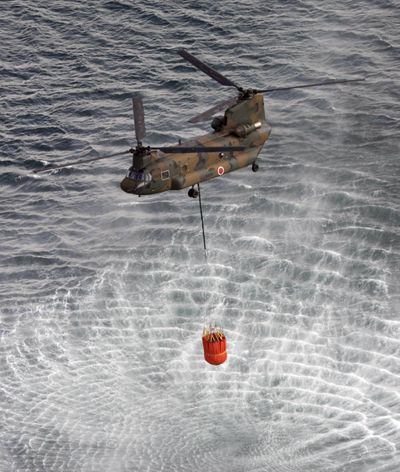Helicopters try to cool reactors at Japan plant
Dropped loads of water, power lines among efforts to avert meltdown

SENDAI, Japan – Japanese authorities embarked on desperate new measures to avert full-scale meltdowns at a quake-battered nuclear plant today, dispatching helicopters to drop tons of water on the reactors and readying water cannons to cool a spent-fuel pool that an American official said was responsible for “very significant radiation levels.”
At the same time, public anger mounted over the government’s lagging efforts to provide relief for the survivors of last week’s earthquake and tsunami.
U.S. and Japanese officials appeared to disagree on the magnitude of the nuclear crisis, as the White House recommended Wednesday that American citizens remain at least 50 miles away from the stricken plant, much farther than the 12-mile evacuation radius given by the Japanese government.
The plant’s operator, Tokyo Electric Power Co., planned to use the water cannons, normally used for crowd control, to try to douse the overheated and possibly dry spent-fuel pool at the No. 4 reactor of the Fukushima Daiichi plant, about 150 miles north of Tokyo. Without cooling, the spent rods could emit dangerous levels of radiation.
The power company was also racing to install a new power line to the plant. The failure of primary power systems and backup generators that were swamped by the tsunami six days earlier has contributed to the escalating crisis.
At midmorning, military helicopters began dumping water on two of the damaged reactors, but after four flybys, the operation was suspended, public broadcaster NHK reported, citing defense officials. A day earlier, gusting winds and high radiation levels also forced the military to scrap the water drops.
Confusion persisted as to what was actually happening inside the plant’s six reactors.
Japan’s Kyodo News service, citing government sources, reported that the U.S. military would deploy unmanned, high-altitude reconnaissance aircraft to take images of the building that houses the No. 4 reactor to determine the status of its spent-fuel pool.
Unquestionably, the situation is dire. The units housing the Nos. 1, 2 and 3 reactors have all been hit by explosions, and their radioactive cores have begun to at least partially melt down, authorities have acknowledged. Fires broke out for two days running in the building housing the No. 4 reactor, and temperatures have been rising in Nos. 5 and 6.
In Washington, Nuclear Regulatory Commission Chairman Gregory Jaczko said at a congressional hearing that all of the water had evaporated from the spent-fuel pool at the No. 4 reactor. Japanese officials contended today that military spotters had confirmed from the air that there was still water in the pool.
Acting on Jaczko’s advice, the White House made its recommendation that U.S. citizens keep 50 miles or more away.
Jaczko told lawmakers that the 50-mile evacuation radius was based largely on concerns about the spent-fuel pool, which is believed to be seriously damaged and responsible for “very significant radiation levels likely around the site.” The pool, which contains an estimated 125 tons of uranium fuel pellets, is not enclosed in a containment vessel; if the pellets start burning, radiation will escape directly into the environment.
The crisis has threatened to overshadow the massive humanitarian needs brought on by the quake and tsunami, and officials of the hardest-hit communities – abandoning customary discretion – are beginning to make unusually harsh public statements about the central government’s ineffective relief efforts. The governor of Fukushima prefecture, Yuhei Sato, told NHK that the anger and anxiety of those in the earthquake zone had reached a “boiling point.”
Food, water, medicine and electricity are all in short supply, a shocking turn of events for citizens of one of the world’s most affluent societies. Nearly a week after the quake and tsunami, many people don’t know the fate of loved ones. Thousands are missing.